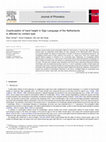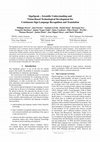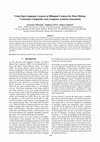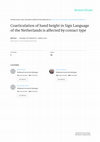Papers by Onno A . Crasborn
The user has requested enhancement of the downloaded file.

A B S T R A C T Recently, several studies found coarticulation effects for hand location in Ameri... more A B S T R A C T Recently, several studies found coarticulation effects for hand location in American Sign Language. In the present study, we established similar effects for Sign Language of the Netherlands (NGT). Moreover, we examined whether the degree of coarticulation of location is sensitive to phonological distinctions. We investigated whether types of major locations in the lexicon (i.e., 'weak hand', 'torso', and 'neutral space') showed different degrees of sensitivity to the surrounding signs. Additionally, we investigated whether different types of movement (i.e., initial contact or final contact with the body) influenced the susceptibility of a sign to change its location under the influence of neighbouring signs. Five deaf adult signers participated in our study. The data were collected using CyberGlove and Flock of Bird, respectively tracking the bending of the fingers with 22 resistant bend-sensors and the X, Y, and Z coordinates. Location of hand height was measured in sign series, comparing the effect of surrounding signs at high and low locations. Results showed that height of the neighbouring signs influenced location height of the target sign. Moreover, coarticulation of location was sensitive to phonological distinctions in the lexicon. Strongest effects of coarticulation were observed at the location 'weak hand', and were heavily influenced by contact type.
This paper describes the strategies that have been developed for creating consistent gloss annota... more This paper describes the strategies that have been developed for creating consistent gloss annotations in the latest update to the Corpus NGT. Although the project aims to embrace the plea for ID-glosses in Johnston (2008), there is no reference lexicon that could be used in the creation of the annotations. An idiosyncratic strategy was developed that involved the creation of a temporary 'glossing lexicon', which includes conventions for distinguishing regional and other variants, true and apparent homonymy, and other difficulties that are specifically related to the glossing of two-handed simultaneous constructions on different tiers.

The SignSpeak project will be the first step to approach sign language recognition and translatio... more The SignSpeak project will be the first step to approach sign language recognition and translation at levels already obtained in similar technologies such as automatic speech recognition or statistical machine translation of spoken languages. Deaf communities revolve around sign languages as they are their natural means of communication. Although deaf, hard of hearing and hearing signers can communicate without problems amongst themselves, there is a serious challenge for the deaf community in trying to integrate into educational, social and work environments. The overall goal of SignSpeak is to develop a new vision-based technology for recognizing and translating continuous sign language to text. New knowledge about the nature of sign language structure from the perspective of machine recognition of continuous sign language will allow a subsequent breakthrough in the development of a new vision-based technology for continuous sign language recognition and translation. Existing and new publicly available corpora will be used to evaluate the research progress throughout the whole project.
While data-driven learning algorithms are well-known and established methods for automatic spoken... more While data-driven learning algorithms are well-known and established methods for automatic spoken language translation and recognition , existing sign language data collections are hardly usable for a sufficient training of the underlying statistical models. In this paper, we briefly recapitulate the mechanisms of machine-based natural language processing. Detailed guidelines for the transcription of sign languages, both for glosses and spoken language translations, are given. While useful for data-driven methods the proposed guidelines do not result in a loss of linguistic accuracy.

We investigated whether there are quantitative phonetic differences between the kinematic propert... more We investigated whether there are quantitative phonetic differences between the kinematic properties of the lexical sign movements versus those of the transitional movements between signs in signed languages. A Cyberglove and an accessory location and orientation sensor (Flock of Birds system) were used to capture the phonetic movement of the fingers of signers of Sign Language of the Netherlands (NGT). Changes across the coordinates on the X, Y, and Z-axes were examined. Two fluent users of NGT produced a set of sign pairs. The main result was a lower velocity in the transitional movements in comparison to the lexical movements. This difference may help the perceiver of sign language to distinguish the lexical movements from the transitional movements in the signing stream. Moreover, the development of automatic recognition of signed languages could benefit from those specific differences in velocity.
Sign Language & Linguistics, 2012

The two symmetrical manual articulators (the hands) in signed languages are a striking modalitysp... more The two symmetrical manual articulators (the hands) in signed languages are a striking modalityspecific phonetic property. The weak hand can maintain the end position of an articulation while the other articulator continues to produce additional signs. This weak hand spreading (hold) has been analysed from various perspectives, highlighting its prosodic, syntactic, or discourse properties. The present study investigates corpus data from Sign Language of the Netherlands (NGT) and Russian Sign Language (RSL), two unrelated sign languages, in order to question the necessity of a sign-language specific notion of ‘buoy’ introduced in the discourse analysis of American Sign Language by Liddell (2003). Buoys are defined as weak hand holds that serve as a visible landmark throughout a stretch of discourse, and several types are distinguished based on their function and form. In the analysis of nearly two and a half hours of narratives and conversations from NGT and RSL, we found over 600 weak hand holds. We show that these holds can be analysed in terms of regular phonetic, syntactic, semantic, or discourse notions (or a combination thereof) familiar from the linguistic study of spoken languages, without the need for a sign language-specific notion of ‘buoy’.

More and more sign languages nowadays are now documented by large scale digital corpora. But expl... more More and more sign languages nowadays are now documented by large scale digital corpora. But exploiting sign language (SL) corpus data remains subject to the time consuming and expensive manual task of annotating. In this paper, we present an ongoing research that aims at testing a new approach to better mine SL data. It relies on the methodology of corpus-based contrastive linguistics, exploiting SL corpora as bilingual corpora. We present and illustrate the main improvements we foresee in developing such an approach: downstream, for the benefit of the linguistic description and the bilingual (signed-spoken) competence of teachers, learners and the users; and upstream, in order to enable the automatisation of the annotation process of sign language data. We also describe the methodology we are using to develop a concordancer able to turn SL corpora into searchable translation corpora, and to derive from it a tool support to annotation.

Journal of Phonetics, 2013
Language. In the present study, we established similar effects for Sign Language of the Netherlan... more Language. In the present study, we established similar effects for Sign Language of the Netherlands (NGT). Moreover, we examined whether the degree of coarticulation of location is sensitive to phonological distinctions. We investigated whether types of major locations in the lexicon (i.e., 'weak hand', 'torso', and 'neutral space') showed different degrees of sensitivity to the surrounding signs. Additionally, we investigated whether different types of movement (i.e., initial contact or final contact with the body) influenced the susceptibility of a sign to change its location under the influence of neighbouring signs. Five deaf adult signers participated in our study. The data were collected using CyberGlove and Flock of Bird, respectively tracking the bending of the fingers with 22 resistant bend-sensors and the X, Y, and Z-coordinates. Location of hand height was measured in sign series, comparing the effect of surrounding signs at high and low locations. Results showed that height of the neighbouring signs influenced location height of the target sign. Moreover, coarticulation of location was sensitive to phonological distinctions in the lexicon. Strongest effects of coarticulation were observed at the location 'weak hand', and were heavily influenced by contact type.
We propose best practices for gloss annotation of sign languages taking into account the needs of... more We propose best practices for gloss annotation of sign languages taking into account the needs of data-driven approaches to recognition and translation of natural languages. Furthermore, we provide reference numbers for several technical aspects for the creation of new sign language data collections. Most available sign language data collections are of limited use to data-driven approaches, because they focus on rare sign language phenomena, or lack machine readable annotation schemes. Using a natural language processing point of view, we briefly discuss several sign language data collection, propose best practices for gloss annotation stemming from experience gained using two large scale sign language data collections, and derive reference numbers for several technical aspects from standard benchmark data collections for speech recognition and translation.
This paper describes the strategies that have been developed for creating consistent gloss annota... more This paper describes the strategies that have been developed for creating consistent gloss annotations in the latest update to the Corpus NGT. Although the project aims to embrace the plea for ID-glosses in Johnston , there is no reference lexicon that could be used in the creation of the annotations. An idiosyncratic strategy was developed that involved the creation of a temporary 'glossing lexicon', which includes conventions for distinguishing regional and other variants, true and apparent homonymy, and other difficulties that are specifically related to the glossing of two-handed simultaneous constructions on different tiers.
Linguistics in the Netherlands, 2009
Sign Language & Linguistics, 2012
Onno Crasborn studied general linguistics (MA, 1995) and wrote an award-winning PhD dissertation ... more Onno Crasborn studied general linguistics (MA, 1995) and wrote an award-winning PhD dissertation on phonetic variation in Sign Language of the Netherlands (2001). After obtaining a BA degree in sign language interpreting from the Hogeschool Utrecht in 2005, he has been combining linguistic research with interpreting work. Since the completion of the Corpus NGT, a large online video corpus of interactive sign language data (mid 2008), he is leading a research project on the prosodic role of the non-dominant hand in signing.








Uploads
Papers by Onno A . Crasborn
Powerpoint available upon request.
Weak Drop (hereafter WD) is the optional deletion of one hand in the articulation of two-handed signs. In this paper we study both the formational and iconic properties of signs undergoing WD and the contextual features that correlate with the occurrence of WD in the Corpus NGT.
WD has been acknowledged early in the literature on ASL phonology and reported for various sign languages since then. A first explanation for this process was proposed by Battison (1974) who suggested that the more symmetric a sign is, the more likely it is to be articulated with one
hand. Other features appear to have a blocking effect on WD (Battison 1974; Padden and Perlmutter 1987; Brentari 1998). These results were partly contradicted in a study by Van der Kooij (2001) on signers’ intuitions, who showed that asymmetric signs may also undergo WD
in NGT, whereas a motivated relation between the two articulators may inhibit WD in symmetrical signs. Elements of the phonetic context have also been reported to influence the realization of WD (Nishio 2009 on DGS; Xavier 2012 on Libras).
The present study focuses on the occurrence of WD in dialogues, aiming to better understand the variation pattern of this phenomenon by: (1) further investigating to which extent the probability of WD may be explained by phonological elements of signs or the iconic mapping
between the form and the meaning of the sign; (2) investigating which elements in the immediate phonetic context favor or inhibit the realization of WD. Our study relies on the annotated parts (about 20%) of the Corpus NGT (Crasborn et al. 2008ab), which contains the recordings of 92 adult deaf signers of all ages and from different parts of the Netherlands. The analysis of WD is made possible by the specific structure of the annotation files, containing independent gloss tiers for the two hands (Crasborn et al. 2014).